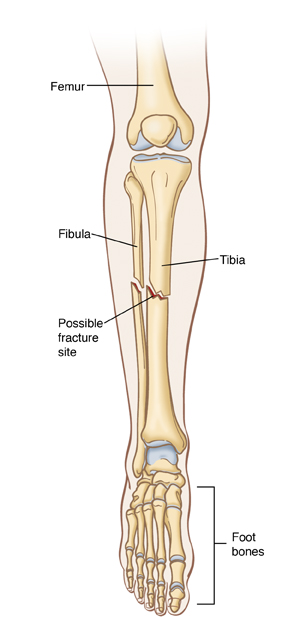Your child has a fracture, or broken bone, in 1 of the bones in the leg. A fracture often causes pain, swelling, and bruising.
To confirm the fracture, X-rays or other imaging tests are done.
The leg or foot may be put into a splint, cast, or special boot. This holds the bone in place while it heals. A severe fracture may need surgery.
Until the end of a child’s teen years, bones contain growth plates. A growth plate allows the bone to grow as your child grows. If a growth plate is fractured, there’s a small chance that it will affect the future growth of the bone. You will be told whether a growth plate is involved in your child’s fracture. A growth plate fracture will be watched closely as it heals.
Home care
Medicines
-
The healthcare provider may prescribe medicines for pain and swelling. Or your child may use over-the-counter medicine as directed by the provider. Follow the provider’s instructions when giving these medicines to your child.
-
Always talk with your child's provider before giving these medicines if your child has chronic liver or kidney disease, or has ever had a stomach ulcer or gastrointestinal bleeding.
-
Don’t use ibuprofen for children younger than 6 months old.
-
Don’t give your child aspirin. Taking aspirin can put your child at risk for Reye syndrome. This is a rare but very serious disorder that most often affects the brain and liver.
General care
-
If your child has been given crutches, they should use them to walk. Your child should not walk or put weight on the injured extremity until the provider says it’s OK. Your child should never put weight on a splint, which will break if walked on.
-
Keep the leg raised to reduce pain and swelling. This is most important during the first 48 hours after injury. As often as possible, have your child sit or lie down. Then place pillows under the child’s leg until the foot is raised above heart level. Encourage your child to move their toes often.
-
You must regularly check that your child's toes are pink and able to wiggle. If there is a change in the movement or color of the toes, contact your healthcare provider immediately.
-
Apply a cold pack to the injury to control swelling. Hold the pack on the injured area for 15 to 20 minutes. Do this every 1 to 2 hours for the first day. Continue this 3 to 4 times a day for the next 2 days, then as needed.
-
To make an ice pack, put ice cubes in a plastic bag that seals at the top. Wrap the bag in a clean, thin towel or cloth. Never put ice or an ice pack directly on your skin. The ice pack can be put right on the cast or splint. If your child has a boot, open it to apply an ice pack, unless told otherwise. As the ice melts, be careful that the cast or splint doesn't get wet.
-
Care for a splint or cast as you’ve been instructed. Don’t put any powders or lotions inside the splint or cast. Keep your child from sticking objects into the splint or cast.
-
Keep the splint, cast, or boot dry. Unless you’re told otherwise, a boot can be removed for bathing.
-
When bathing, a splint or cast should be protected with 2 large plastic bags. Place 1 bag outside of the other. Tape each bag with duct tape at the top end. Younger children may be hurt when removing duct tape. For younger children, put a rubber band around the top end of each bag. Water can still leak in. So it's best to keep the splint, cast, or boot away from water. If a fiberglass splint or cast gets wet, dry it with a hair dryer on a cool setting.
Follow-up care
Follow up with your healthcare provider as advised. Follow-up X-rays may be needed to see how the bone is healing. If your child was given a splint, it may be changed to a cast at the follow-up visit. If you were referred to a specialist, make that appointment right away.
If X-rays were taken, you will be told of any new findings that may affect your child’s care.
Special note to parents
Healthcare providers are trained to recognize injuries like this one in young children as a sign of possible abuse. Several healthcare providers may ask questions about how your child was injured. Healthcare providers must by law ask you these questions. This is done for protection of the child. Please try to be patient and not get upset.
When to get medical advice
Call your child's healthcare provider right away if any of the following occur:
-
The splint or cast becomes wet or soft
-
The splint or cast is too tight or too loose
-
The splint or cast has a bad smell
-
There is increasing swelling or pain
-
Your child has severe pain that is not relieved by rest or recommended medicines
-
The toes of the foot on the injured leg are cold, blue, numb, or tingly
-
Your child can’t move the toes of the foot on the injured leg
-
Your child develops a fever of 100.4 °F or higher, or as advised by your healthcare provider.
Featured in


